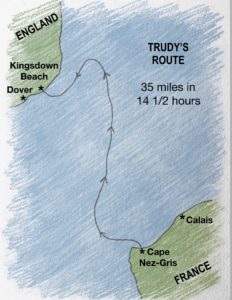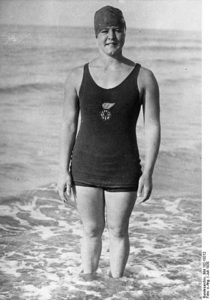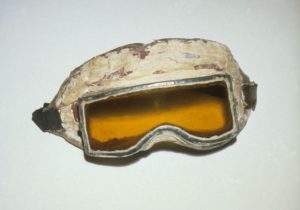
Awesome Athlete
Imagine swimming so far and for so long that when you finally get out of the water, you have to show officials your passport. And in route, your only company are boats, jellyfish, and the occasional shark! Travel through time to 1926 and across the English Channel to meet 19 year old Gertrude Ederle…
Her Ruby Shoe Moment
The Power of the Wand
Her Yellow Brick Road
Brains, Heart & Courage
Glinda’s Gallery
Just the Facts
Her Ruby Shoe Moment
Gertrude (“Trudy”) Ederle plunged into the frigid water of the Atlantic Ocean. It was 7:08 AM on August 6, 1926 when she left the beach on the west coast of France — her goal was England. Trudy was determined to become the first woman to swim across the English Channel.
As Trudy swam along, she was motivated by the voices of her family and coach. They were aboard the tugboat, Alsace, which accompanied Trudy across the Channel. Her sister, Meg, swam with her from time to time. She also sang Trudy’s favorite songs, which helped Trudy keep her stroke slow and steady.
A few reporters were on board the Alsace as well — Trudy was sponsored by the Chicago Tribune and New York Daily News, which gave them exclusive coverage of her swim. They took pictures and updated America on her progress by wireless telegraph.
Trudy had to be ready for whatever came her way. The Channel was known for its unpredictability — sudden storms, freezing temperatures, disorienting fog, powerful currents, jellyfish, an occasional shark, and a lot of boats (back then, it was the busiest shipping lane in the world).
A few miles into the swim, Trudy found herself battling Mother Nature. First, the wind picked up and the sea swelled with 20-foot waves; most people aboard the Alsace became seasick. Then, the currents and tides tossed Trudy about; for nearly an hour, she barely made any progress.

Thousands of people waited for Trudy’s arrival on the beaches of England. Their bonfires guided her into shore. It was 9:40 PM when she walked out of the water at Kingsdown Beach. She was exhausted, freezing, and disoriented. But there was one more obstacle between her and a hot bath — an English official asked to see her passport.
At age 19, Trudy shocked the world. She accomplished her goal of becoming the first woman to swim the Channel. But even more surprising was her official time of 14 hours, 39 minutes — she swam it nearly two hours faster than any man! And no woman beat her record for 24 years.
The Power of the Wand
Trudy shattered America’s views about women with her remarkable accomplishment. Back then, women were considered the “weaker sex” – most people assumed they had little physical strength or stamina. Trudy proved everyone wrong. Overnight, she became one of the most popular athletes in America.
Trudy’s swim inspired thousands of women to participate in sports. In fact, over 50,000 women had earned their American Red Cross swimming certificates by 1930. And they have dominated the water ever since. In fact, American women have won over 200 Olympic medals in swimming over the years – Missy Franklin and Katie Ledecky come to mind. Watch for Regan Smith in the 2020 Tokyo Olympics.
Her Yellow Brick Road
Trudy tried to swim the Channel the previous summer, but failed. She swam for nine hours before her coach pulled her out of the water. She was disqualified. Trudy was confused, angry and embarrassed — she wasn’t tired and could have continued.
But Trudy refused to give up. The first attempt gave her valuable experience and made her mentally tough. It also made her more determined to try again the next summer. And she was going to do it her way.
 Her first step was to hire a new coach, TW Burgess, who successfully swam the Channel after nearly 20 attempts. To get the job, however, Burgess had to promise that he would never pull her out of the water. Period. The decision to quit was hers and hers alone.
Her first step was to hire a new coach, TW Burgess, who successfully swam the Channel after nearly 20 attempts. To get the job, however, Burgess had to promise that he would never pull her out of the water. Period. The decision to quit was hers and hers alone.
Trudy’s team (the “Channel Coo-Coo Club”) traveled to France in June to begin her training. Trudy took charge of the preparations the second time around — from the route she took, to the stroke she swam, to the grease she used, to the outfit she wore, to the snacks she ate.
Route: most swimmers started from the western-most point of France — it was a rocky point called Cape Gris Nez. But Trudy decided to leave from a nearby beach, even though it added an extra mile to her route.
Stroke: the breast-stroke was most popular among long-distance swimmers at the time. But Trudy had learned a new stroke — the American crawl (now it’s the “freestyle”). And she was a natural. So she planned to swim the freestyle across the Channel.
Grease: most ocean swimmers covered themselves with some kind of grease — it protected them from jellyfish stings, helped them glide through the water, and insulated them from the cold (hypothermia was a real concern). Trudy tried a number of different recipes before deciding on her own, which consisted of four different layers (olive oil, petrolatum, lard and lanolin).
Outfit: back then, most women swam in wool dresses, which were bulky and heavy. But Trudy wanted to wear something that wouldn’t slow her down, even if it broke society’s rules. She and her sister, Meg, designed a new outfit for the swim — it was a two-piece swimsuit made from black silk. Trudy also used candle wax to perfect the seal on her goggles.
Snacks: Trudy planned her own diet for the swim — chicken broth, pineapple juice, chocolate, and sugar cubes. She also created her own system for accessing the food, since no one could touch her during the swim. The key was a fishing pole — she ate and drank from a baby bottle tied to the fishing line.
Brains, Heart & Courage
Trudy had a rocky introduction to the sport of swimming — she almost drowned when she was seven years old. After that, she was determined to learn how to swim. So, her parents tied her to the end of a rope and lowered her into the Shrewsbury River, at their summer home in New Jersey. And her natural talent became obvious in no time.
When she was 16 years old, Trudy quit high school to focus on swimming full time. And she started breaking records in the same year. Trudy’s older sister, Meg, was her biggest supporter. She was a swimmer herself and recognized Trudy’s talent. She pushed Trudy to become serious about the sport and did the paperwork to enter her in races. She also spent hours with Trudy training in the water.
 Trudy’s swimming career took off when she joined the Women’s Swimming Association in Manhattan. She finally learned some proper technique, including the new freestyle stroke. Its inventor, Lou Handley, taught her the new stroke and she quickly perfected it.
Trudy’s swimming career took off when she joined the Women’s Swimming Association in Manhattan. She finally learned some proper technique, including the new freestyle stroke. Its inventor, Lou Handley, taught her the new stroke and she quickly perfected it.
Trudy also began training for the 1924 Olympics while at the WSA. The WSA founder, Charlotte Epstein, was also the women’s Olympic swimming coach. Trudy competed in Paris as one of “Eppie’s Girls.” She won a gold and two bronze medals (all in freestyle events).
After her success at the Olympics, Trudy began to swim longer and longer distances. In fact, she became the first woman to swim the length of the New York Bay, from the Battery to Sandy Hook, in 1925. The 16 mile trip took her 7 hours, 11 minutes. And it gave her the confidence to tackle the English Channel.
Glinda’s Gallery
Visit Trudy’s digital scrapbook on Pinterest: https://www.pinterest.com/theglindafactor/gertrude-ederle/
Just the Facts
- Trudy was born in New York City on October 23, 1906. She was one of six children born to German immigrants, Henry and Anna. Her family owned a butcher shop, Ederle Brothers Meats, on the Upper West Side. In fact, her uncle passed out free hot dogs at the meat market when he learned that Trudy completed the swim.
- Trudy was partially deaf for most of her life. Her ear drums were damaged from measles as a child. Her hearing was much worse after the Channel swim. She was almost completely deaf by 1928.
- Trudy held 29 US and world swimming records. She was inducted into the National Women’s Hall of Fame in 2003 and the International Swimming Hall of Fame in 1965. She was also named “Queen of the Channel” by the Channel Swimming Association.
- Trudy returned to New York City as a celebrity. The New York Daily News presented her with a red convertible; countless men proposed to her by letter; and a ticker tape parade was held in her honor – over two million people lined the route and chanted her name. It was all overwhelming!
- For a few years after her historic swim, Trudy toured the country and demonstrated her stroke in a glass swimming pool. She even went to Hollywood and made a guest appearance in a silent film about her life, Swim, Girl, Swim.
- Then, Trudy retreated from the spotlight. Some think she had a nervous breakdown from the pressure. She lived in an apartment in Queens with a few roommates (she was engaged once, but never married).
- Trudy devoted the rest of her life to teaching deaf children how to swim at the Lexington School for the Deaf. She also worked at La Guardia airport during World War II, testing the accuracy of flight instruments.
- Trudy died on November 30, 2003 at age 98 (New York Times Obituary December 1, 2003).
Want to Know More?
Dahlberg, Tim, Mary Ederle Ward, and Brenda Greene. America’s Girl: The Incredible Story of How Swimmer Gertrude Ederle Changed the Nation. (New York: St. Martin’s Press, 2009).
Stout, Glenn. Young Woman and the Sea: How Trudy Ederle Conquered the English Channel and Inspired the World. (New York: Houghton Mifflin Harcourt, 2009).


